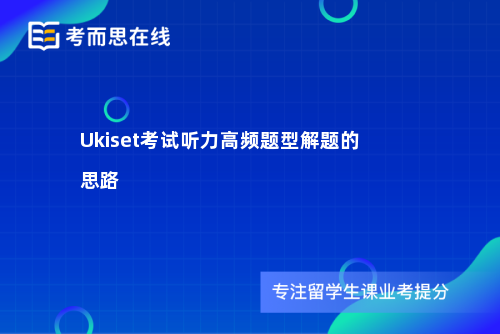
Ukiset考试听力高频题型解题的思路
对于中国考生来说,Ukiset听力绝对是Ukiset考试中的难点之一,所以我们在备考中就要集中精力提高听力水平,由于大部分学生很少会接触这项考试,难免是零基础参加考试,下面一起来学习一下听力高频题型解题的思路!
听力修辞题常见提问形式一览
修辞题通常都是以特殊疑问词开头的特殊疑问句,例如:
Why does the professor say this?(询问使用了何种修辞手段)
A: To encourage the students to think about the issue under a bigger context.
B: To elicit an answer from the students.
C: To compare two different things figuratively to engage his students.
D: To describe an imaginative situation.
How dies the professor illustrate his point about ___? (询问谈话人是如何创造了某种修辞手段的)
A: by comparing X to Y
B: by giving an example of X
Why does the professor say so? (节选了演讲中某一带有修辞用法的部分,让考生回答为什么谈话人用此修辞)
A: To point out a flaw
B: To repeat a point
C: To define an important term
D: To exemplify a key point?

听力修辞题基本解题思路指点
1. 熟悉常用修辞手段,如比喻(又分明喻,暗喻等),夸张,比拟,例证,借代,反问,反复,设问等等。
2. 听原文时即可适时判断谈话人的真实意图,谈话人某句讲话修辞手法运用明显之时,往往就是考点出现之处。
3. 注意根据上线问和谈话气氛来综合回答问题,不要脱离主题凭空猜测谈话人的修辞意图。
修辞题解题技巧实例讲解
Professor: Through much of the last century, America’s faith in freedom and democracy was a rock in a raging sea. Now it is a seed upon the wind, taking root in many nations.
Narrator:Listen again to a part of the lecture. Then answer the question.
Professor: …Now it is a seed upon the wind, taking root in many nations.
Why does the professor say this?
A: To encourage the students to think about the issue under a bigger context.
B: To elicit an answer from the students.
C: To compare two different things figuratively to engage his students.
D: To describe an imaginative situation.
解析:
该题是询问为何使用某种修辞手法。
从谈话节选段落中我们很容易看出,教授使用的是暗喻的方法。
该段落大概的意思是:在上个世纪的大部分时间里,美国式民主和自由的信仰如石沉大海,波澜不惊;而今,却如清风拂絮,撒落人间。
暗喻的方式是为了形成对比,从而激起听者的想象力,活跃课堂谈话的气氛。
综上所述正确答案为C。
当前文章链接:
凡来源标注“考而思”均为考而思原创文章,版权均属考而思教育所有,任何媒体、网站或个人不得转载,否则追究法律责任
上一篇:
下一篇:
免费获得学习规划方案
已有 2563 位留学生获得学习规划方案
马上领取规划
*已对您的信息加密,保障信息安全。













